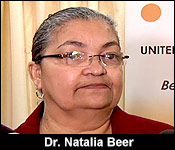The United Nations Population Fund has released its 2018 State of the World Population Report, and this year, the report is titled "the Power of Choice".
The UNFPA focuses on sexual and reproductive health and rights for citizens all over the world, and their State of the World Population Report takes a look at global trends in the growth of the population. This year's report, as the name suggests, seeks to examine how the demographic in most countries has changed from couples having an average of 5 children in the past, to the present day, where most households want significantly smaller families.
The report notes that family size is closely linked to sexual education, health, and income. When the couples have proper access to all of these, they are able to properly choose the family size they want. On the other hand, poorer or less educated couples struggle with making the right choices and options to control how many children they have, since they don't have adequate access to contraception, or the education for proper family planning.
The Report was launched Globally on October 17th, and today, UNFPA's Belize Office, and the Ministry of Health held a media launch at the Biltmore. We spoke with the authorities on this topic in Belize. Here's what they told us about this year's report:
Dr. Pilar Molina - Representative, UNFPA Caribbean
 "It talks about the Fertility Trends worldwide, and the power of choice, and it highlights how many countries have individual and couples who are not having the number of children that they wish to have. Some have more children than they wish, and there are other countries where you have couples and individuals having less children than they would like to have."
"It talks about the Fertility Trends worldwide, and the power of choice, and it highlights how many countries have individual and couples who are not having the number of children that they wish to have. Some have more children than they wish, and there are other countries where you have couples and individuals having less children than they would like to have."
"The countries with high fertility rates those countries, normally the population faces a lack of access to sexual and reproductive health services, lack of education, and and lack of access to comprehensive sexual education, gender imbalances that limit women to choose the number of children that they would like to have."
"And then, you have those countries with low fertility rates, where you can see that it's very difficult for many couple and women to make a balance between career and having children. Also, because child care is very expensive, so they cannot afford to have more children, and also because in these countries [there is] the delay of maternity, infertility issues, and sometimes It's very expensive for couples to get access to those services."
 Dr. Natalia Beer - Maternal and Child Health Advisor, MOH
Dr. Natalia Beer - Maternal and Child Health Advisor, MOH
"The State of the World Population is focusing on the trends of the total fertility rate among the different countries world wide, where we are, and where we were. And Adolescent birthrate play a role, especially for us in Belize, since it is still high, In contributing to this total fertility rate. It's a complex indicator, that is linked to economic and social factors, social determinants where issue highlighted in the report is the issue of choice. And as we discussing earlier, choice needs to be based on information. And information, to gain the knowledge, you need information. And the information has to be timely and correct, otherwise, we end up with indicators like adolescent birth rate, which is not good for the girl, not good for the child, and not good for the country."
The report is available on UNFPA's website at www.unfpa.org.
Of important note is that UNFPA is currently working with the Government UNICEF to come up with a roadmap to address adolescent pregnancy rates in Belize. They say that the local numbers of adolescent pregnancy is cause for concern.



